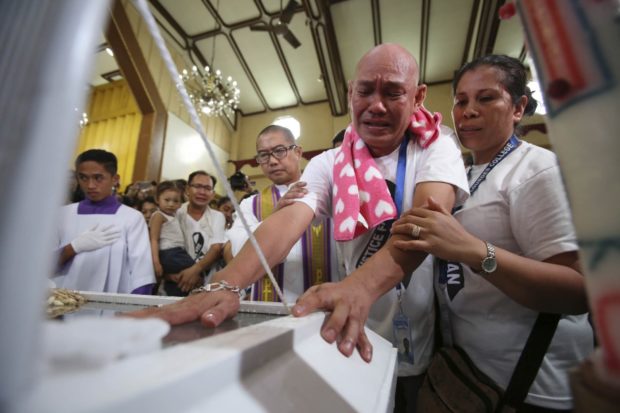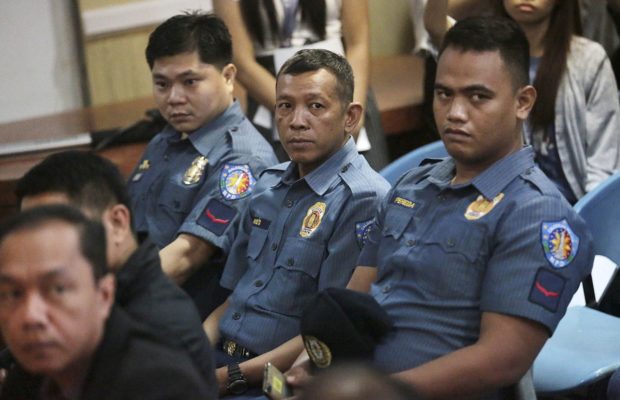Kian’s case: Litmus test for Duterte drug war

DRUG KILLING The parents of Kian delos Santos, who was killed in an alleged shootout with policemen on Aug. 16, 2017, as the Duterte administration waged a bloody crackdown on drug traffickers, grieve over the coffin of their 17-year-old son. —INQUIRER FILE PHOTOS
(First of two parts)
For nearly a year, the biggest challenge to President Rodrigo Duterte’s war on drugs played out in a small courtroom in Caloocan City, where Grade 12 student Kian delos Santos was killed beside a pigsty in a dead-end street in an alleged shootout with police on Aug. 16, 2017.
PO3 Arnel Oares, PO1 Jeremias Pereda and PO1 Jerwin Cruz, all formerly of the Santa Quiteria station, were tried for conspiring to murder and then frame Kian, 17, as a drug courier in a “One-Time, Big-Time” operation.
“That is really bad. That is not in the performance of duty,” President Duterte said in a speech after Kian’s death — a statement at odds with his past promises of immunity for police officers involved in the killing of drug suspects.
After nearly six months, the trial ended on Aug. 30. Caloocan City Regional Trial Court (RTC) Judge Rodolfo Azucena’s decision is expected on Nov. 29.
Article continues after this advertisementHuman rights lawyer Ansheline Bacudio believes a conviction would unravel police narratives of suspects resisting arrest (nanlaban) and help other families exact accountability for the thousands of other dubious deaths in the administration’s war on drugs.
Article continues after this advertisementBacudio, who works with a private group offering pro bono legal services, said a guilty finding could lead to an “outburst” of cases.
Human rights lawyers who work on the ground to assist families of victims of extrajudicial killings or other forms of abuse in the drug war deem Kian delos Santos’ case as a precedent case. Gil Aquino of Centerlaw, the firm that clinched legal victories for the families of San Andres Bukid and Efren Morillo of Payatas, says Thursday’s promulgation would be a litmus test for how the judicial system handles cases alleging state-sponsored violence.
“Kian’s case could set a precedent,” she said. “[Azucena’s decision] would set jurisprudence we could use as leverage for other cases.”
If found guilty, Oares, Pereda and Cruz would become the first policemen to be convicted of abuses in the brutal campaign.
Their acquittal, however, would mean a victory for the status quo and for the Philippine National Police, which has long asserted presumption of regularity in the killing of drug suspects.
Unprecedented fallout
But whatever the decision, the legacy of Kian’s case lies in the reckoning that resulted from his death. The unprecedented fallout prompted not only a legislative inquiry despite the Senate being mostly composed of the President’s allies, but also the sacking of the entire Caloocan police. Eventually, the President took the PNP off the antidrug campaign although he later brought it back.
Kian was not even the first, or the youngest, victim of an extrajudicial killing (EJK). He was among the nearly 90 EJKs across Metro Manila during a bloody two-day crackdown that began in nearby Bulacan province on Aug. 15, 2017.
Earlier, thousands had already been killed in alleged shootouts with police or gunned down by motorcycle-riding assailants, their corpses dumped on roadsides with placards strapped to their chests that said they were drug offenders.
Very few challenged these killings in court. But Saldy and Lorenza delos Santos, Kian’s parents, filed charges against the three officers and others from the Santa Quiteria station on Aug. 25, 2017. It would become among the first EJKs to move to trial.
Oares, Pereda and Cruz were the only ones found liable for murder among the Santa Quiteria officers.
Since Jan. 25 when state prosecutors filed the charges, Branch 125—a humid, cramped courtroom on the second floor of the decrepit Caloocan judicial building—had been the battleground of two wildly conflicting narratives on how Kian was killed. Judge Azucena held marathon hearings, often twice a week.

ENDING COURT DRAMA PO1 Jerwin Cruz, PO3 Arnel Oares and PO1 Jeremias Pereda, who were accused of killing Kian delos Santos, show up at the Department of Justice for the preliminary investigation of the case on Sept. 14, 2017. The Caloocan City Regional Trial Court is expected to announce its decision on Thursday.
For about six months, the Delos Santos couple sat across from the men whom they had accused as killing their son.
The three officers, cuffed and clad in prison yellow, often sat stone-faced while the prosecution presented its witnesses. They filed multiple appeals to stay in a regional police jail, citing threats to their life.
Azucena eventually allowed Oares to stay there. Pereda and Cruz were held at the Valenzuela City Jail.
Eyewitnesses
The prosecution’s first and strongest eyewitness was “Julie,” a 14-year-old girl under the custody of Sen. Risa Hontiveros. On March 19, she claimed in court that she saw Pereda and Oares beat and slap Kian in the face after their asset, Renato Loveras, pointed out the 17-year-old as he was walking home.
She said they forced him to hold a gun, and when he resisted, covered his face with his own shirt pulled from his back. They dragged him across the basketball court while he shouted in protest, saying he had exams coming: “Huwag po, huwag po, may exams po ako!”
Pereda and Cruz’s lawyer, Oliver Yuan, needled Julie to tears: If you were in fear, why did you stay so long by the drugstore? You said the basketball court was dimly lit, how can you identify the men? You said they were by the basketball court, how can you have seen them from the drugstore? How can you be so sure it was Kian?
The ruthless cross-examination set the tone for the other witnesses who took the stand. In separate testimonies on April 2 and 5, “Abby” and “Mae” said they also saw two men dragging someone while another man—presumably Cruz—followed behind. Abby said it was Kian; Mae said it was an “asset.”
Both watched the man being dragged to the Tullahan River. Later, they heard gunshots from Abby’s house.
Abby recognized Kian’s clothing—blue shirt, green boxer shorts—in which it would have been impossible to hide packets of “shabu” (crystal meth), let alone a .45-caliber pistol. These items were supposedly found on Kian’s body.
Forensic evidence
By May 7, the evidence had shifted from eyewitnesses to forensic science.
Hiyasmin Abbarientos of the National Bureau of Investigation’s firearms investigation division testified that the downward trajectory of the bullets, based on the grazes and dents found on the crime scene, suggested that Kian’s killers were standing over him.
Senior Insp. Jocelyn Cruz of the Northern Police District (NPD) and Erwin Erfe of the Public Attorney’s Office—medicolegal officers who conducted autopsies on Kian’s body—discovered different numbers of bullet wounds.
Cruz found only two, from shots that pierced Kian’s head from his left ear, which showed that his assailant possibly fired from “at least two feet” away.
Erfe found a third bullet wound in the back. Both forensic officers agreed Kian was shot from behind while he was sitting or on his knees.
On the stand, Oares admitted that it was he who had shot Kian, but claimed it was in self-defense. This corroborated paraffin tests where he tested positive for gunpowder nitrates.
Kian tested negative on both hands.
On Kian’s first death anniversary—Aug. 16, 2018—Chief Insp. Jerry Damaso of the NPD firearms identification laboratory said he could not testify to the veracity of a firearms report where he supposedly concluded that the two 9mm bullet casings found on the scene came from the same firearm issued to Oares.
Pereda and Cruz backed their leader’s testimony during the trial’s final stretch. They refuted claims that it was Kian they were seen dragging, head down, in security footage from the barangay.
They claimed that it was “Jay-r,” their asset, and that Oares had ordered them to secure him while their leader responded to gunshots near where Kian’s body was found.
Kian was dead by the time they got near the Tullahan River, they said.
‘Inconsequential’
In their final plea for acquittal, Pereda and Cruz seemed to admit they had put up a weak defense. “But [it] is inconsequential,” they said, “as long as the prosecution has not discharged its burden of proof in establishing the commission of the crime.”
Said Randy delos Santos, Kian’s uncle: “From Day 1 until the end, I am convinced we have presented nothing but the truth before the court. I pray day and night that the judge gives us what is due.”
For the three officers, privileged by the dual presumption of regularity in their performance of duty and of innocence, doubt is all they need to win.